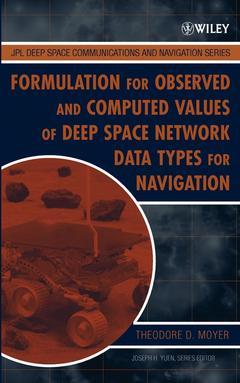Formulation for Observed and Computed Values of Deep Space Network Data Types for Navigation JPL Deep-Space Communications and Navigation Series
Auteur : Moyer Theodore D.

Drawing on fundamental principles and practices developed during decades of deep space exploration at the California Institute of Technology's Jet Propulsion Laboratory (JPL), this book documents the formation of program Regres of JPL's Orbit Determination Program (ODP). Program Regres calculates the computed values of observed quantities (e.g., Doppler and range observables) obtained at the tracking stations of the Deep Space Network, and also calculates media corrections for the computed values of the observable and partial derivatives of the computed values of the observables with respect to the solve-for-parameter vector-q. The ODP or any other program which uses its formulation can be used to navigate a spacecraft anywhere in the solar system.
A publication of the JPL Deep Space Communications and Navigation System Center of Excellence (DESCANSO), Formulation for Observed and Computed Values of Deep Space Network Data Types for Navigation is an invaluable resource for graduate students of celestial mechanics or astrodynamics because it:
* features the expertise of today's top scientists
* places the entire program Regres formulation in an easy-to-access resource
* describes technology which will be used in the next generation of navigation software currently under development
The Deep Space Communications and Navigation Series is authored by scientists and engineers with extensive experience in astronautics, communications, and related fields. It lays the foundation for innovation in the areas of deep space navigation and communications by conveying state-of-the-art knowledge in key technologies.
Preface.
Acknowledgments.
Introduction.
Time Scales and Time Differences.
Planetary Ephemeris, Small-Body Ephemeris, and Satellite Ephemerides.
Spacecraft Ephemeris and Partials File.
Geocentric Space-Fixed Position, Velocity, and Acceleration Vectors of Tracking Station.
Space-Fixed Position, Velocity, and Acceleration Vectors of a Landed Spacecraft Relative to Center of Mass of Planet, Planetary System, or the Moon.
Algorithms for Computing ET-TAI.
Light-Time Solution.
Angles.
Media and Antenna Corrections.
Calculation of Precision Light Times and Quasar Delays.
Partial Derivatives of Precision Light Times and Quasar Delays.
Observables.
References.
Acronyms.
Index.
Date de parution : 01-2003
Ouvrage de 576 p.
16.1x23.8 cm
Thème de Formulation for Observed and Computed Values of Deep... :
Mots-clés :
fundamental; reference; field; navigation; deep; valuable; principles; space; program; formation; documents; orbit; jpls; book; determination; regres; values; quantities; program regres; range; tracking stations; network; observables
